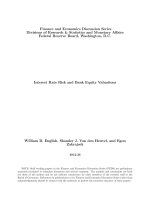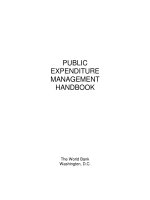United States General Accounting Office Washington, D.C. 20548 Comptroller General of the United States _part2 pot
Bạn đang xem bản rút gọn của tài liệu. Xem và tải ngay bản đầy đủ của tài liệu tại đây (1.12 MB, 11 trang )
B-114881
Adequacy of
Funding
The Federal Deposit Insurance Corporation Improvement Act of 199 1
for Resolving Troubled
(Public Law 102~242), enacted December 19,199 1, provided
FDIC
with
increased authority to borrow funds to cover both losses and working
Banks Is Dependent on
capital needs related to resolution activity. The
FDIC
Improvement Act
Future Events
increased
FDIC’S
authority to borrow funds from the Treasury on behalf of
the Bank Insurance Fund and the Savings Association Insurance Fund
(SAIF)”
to cover losses incurred in resolving troubled institutions to
$30 billion. However, it also requires
FDIC
to recover these loss funds
through premium assessments charged to insured institutions. In addition,
FDIC
may borrow funds for working capital, but the amount of its
outstanding working capital borrowings is subject to a formula in the act
that limits
FDIC’S
total outstanding obligations.
FDIC
borrows working
capital on behalf of the Fund from the Federal Financing Bank. Such
borrowings are to be repaid primarily from the management and
disposition of failed financial institution assets.
The adequacy of the funding the act provides to deal with the Fund’s
exposure to troubled banks is subject to a number of uncertainties. To the
extent actual recoveries from the management and disposition of failed
bank assets fall short of expectations, the ultimate cost of resolving these
institutions will increase. If this occurs, the Fund may require additional
loss funds to cover the shortfall. Furthermore, it is difficult to project the
Fund’s long term exposure to losses from troubled banks. While the
$30 billion in loss funds appears to be sufficient based on
FDIC’S
short-term
projections of identifiable costs the Fund faces from troubled banks, any
additional banks requiring resolution could result in the need for increased
funding.
Future events in the thrift industry could also significantly affect the
adequacy of the funding provided. Under
the
FDIC
Improvement Act,
FDIC
is
authorized to borrow $30 billion from the Treasury to cover losses
4
incurred in resolving institutions insured by both the Bank Insurance Fund
and
SAIF. FIRREA
also established
RTC
to resolve thrifts whose deposits had
been insured by the Federal Savings and Loan Insurance Corporation
(FSLIC)
and that had been, or will be, placed into conservatorship or
receivership from January 1, 1989, through August 8, 1992. The
Resolution Trust Corporation Refinancing, Restructuring, and
3SAIF was established under the Financial Institutions Reform, Recovery, and Enforcement Act of 1989
(FIRREA) (Public Law 101-73) to insure the deposits of federally-insured savings associations (thriftu)
and thrift deposits acquired by so-called “Oakar banks” under Section 5(d)(3) of the Federal Deposit
Insurance Act. Through September 30, 1993, however, SAIF wUI share resolution responsibhity with
the Resolution Trust Corporation (RTC).
Page 10
GAO/AFMD-92-73 Bank Insurance Fund
This is trial version
www.adultpdf.com
B-114881
Improvement Act of 199 1 (Public Law 102-233), enacted on December 12,
1991, extended
RTC'S
resolution authority to thrifts placed into
conservatorship or receivership through September 30, 1993. After this
date, responsibility for resolving all federally-insured thrifts will be shifted
to
SAIF.4
Favorable interest rates could delay many thrift failures until after
September 30, 1993. If the costs of resolving these institutions exceed
SAIF'S
other available funding sources,
FDIC
could be forced to use some of
the $30 billion in borrowing authority to cover
SAIF’S
losses. Were this to
occur, the funding the
FDIC
Improvement Act provides may not be
sufficient to cover the exposure posed to both
SAIF
and the Bank Insurance
Fund from their respective industries.
Additional Efforts to
The last 4 years have demonstrated how quickly unanticipated
events can
Recapitalize the F’und
adversely impact the banking industry and ultimately deplete the reserves
of the Fund. The Fund’s dramatic decline from a high of $18.3 billion as of
May Be Needed
December 31, 1987, to its reported deficit of $7 billion as of December 31,
199 1, illustrates the extent and swiftness in which rising numbers and
costs of bank failures have depleted the Fund. At the time the Fund
attained its highest level, the ratio of its reserves to insured deposits
equaled approximately 1.10 percent. In the succeeding 4 years, as the
Fund’s reserve position declined by over $25 billion, the ratio of its reserve
balance to insured deposits declined precipitously to a negative 0.36
percent as of December 3 1, 199 1.
The
FDIC
Improvement Act contains provisions to recapitalize the Fund. It
requires
FDIC
to set semiannual assessment rates for insured institutions
that are sufficient to increase the Fund’s ratio of its reserves to insured
a
deposits to a designated ratio established by
FIRREA
of 1.25 percent no
later than 1 year after setting the assessment rates, or in accordance with a
recapitalization schedule established by
FDIC.
This schedule must specify,
at semiannual intervals, target reserve ratios for the Fund, culminating in a
ratio of reserves to insured deposits that is equal to the designated reserve
ratio no later than 15 years after the date on which the schedule becomes
effective. The
FDIC
Improvement Act also requires FDIC to implement a
4Any thrift requiring resolution after September 30, 1993, which had previously been under RTC
consematorship or receivership may be transferred back to RTC for resolution in accordance with the
provisions of the Resolution Trust Corporation Refinancing, Restructuring, and Improvement Act of
1991.
Page 11
GAO/AFMD-92-73 Bank Insurance Fund
This is trial version
www.adultpdf.com
B-114881
risk-based premium system by January 1, 1994. Under this system, insured
institutions considered to pose a greater risk of loss to the Fund would be
assessed at higher rates than stronger, well capitalized and managed
institutions. The act permits
FDIC
to implement a transitional risk-based
premium system prior to January 1, 1994.
FDIC
recently issued a proposal for public comment to increase the
semiannual assessment rates charged to insured institutions from the
current rate of 23 cents per $100 of domestic deposits to 28 cents,
effective January 1, 1993. This proposed rate increase is based on an
analysis of the condition of the Fund and its ability to achieve the
designated reserve ratio over the next 15 years. Concurrent with this
proposal,
FDIC
proposed to shift to a risk-based premium system, also
effective January 1, 1993. The initial assessment rates under the proposed
risk-based premium system range from between 25 cents and 3 1 cents per
$100 of domestic deposits and would vary from institution to institution
based on the regulators’ assessment of the institution’s condition and
health. If
FDIC
implements such a risk-based premium structure by
January 1, 1993, it estimates that the proposed assessment rate of 28 cents
per $100 of domestic deposits would become the average assessment rate
FDIC
would charge.
Even under the proposed assessment rate increase, there is considerable
risk that the Fund will not achieve the designated reserve ratio within the
maximum 15 year period allowed for in the
FDIC
Improvement Act.
FDIC
estimates that, with an assessment rate of 28 cents per $100 of domestic
deposits, the probability of the Fund’s reserves achieving the designated
reserve ratio in 15 years is only 60 percent. Given the uncertainties
discussed above that may ultimately impact asset recovery values, costs
from future resolution activity, and the adequacy of the funding provided
under the act, it is important to replenish the Fund’s reserves as
a
expeditiously as possible. As the last 4 years have shown, unexpected
events such as economic downturns and their resulting impact on the
Page 12 ‘GAO/AFMD-92-73 Bank Insurance Fund
This is trial version
www.adultpdf.com
B-114831
banking industry can quickly deplete reserve levels once considered to be
healthy. It is important that the Fund be recapitalized to avoid further
borrowings from the taxpayers to
finance
losses from financial institution
failures. This is consistent with previous positions we have taken regarding
the need to recapitalize the Fund.6
Charles A. Bowsher
Comptroller General
of the United States
May 11,199Z
“Hcbuildi~the Bank Insurance Fund, (GAO/T-GGD-91-25, April 26,1991).
Page 13
GAOIAFMD-92-73 Bank Insurance Fund
This is trial version
www.adultpdf.com
Report on Internal Control Structure
We have audited the financial statements of the Bank Insurance Fund as of
December 31, 1991 and 1990, and have issued our opinion thereon. This
report pertains only to our consideration of the Federal Deposit Insurance
Corporation’s
(FDIC)
internal control structure as it relates to the Bank
Insurance Fund for the calendar year ended December 3 1,199 1. The
report on our consideration of the Corporation’s internal control structure
as it relates to the Fund for the calendar year ended December 31, 1990, is
presented in
GAO/AFMD-92-24,
dated November 12, 199 1,
We conducted our audit in accordance with generally accepted government
auditing standards. Those standards require that we plan and perform the
audit to obtain reasonable assurance about whether the financial
statements are free of material misstatement. In planning and performing
our audit, we considered the internal control structure of
FDIC
as it relates
to the Fund in order to determine the auditing procedures needed for
purposes of expressing our opinion on the financial statements and not to
provide assurance on the internal control structure.
FDIC's
management is responsible for establishing and maintaining an
internal control structure over the Bank Insurance Fund. In fulfilling this
responsibility, estimates and judgments by management are necessary to
assess the expected benefits and related costs of internal control structure
policies and procedures. The objectives of an internal control structure are
to provide management with reasonable, but not absolute, assurance that
assets are safeguarded against loss from unauthorized use or disposition
and that transactions are executed in accordance with management’s
authorization and recorded properly to permit the preparation of financial
statements in accordance with generally accepted accounting principles.
Because of the inherent limitations of any internal control structure, errors
or irregularities may nevertheless occur and not be detected. Also,
b
projection of any evaluation of the internal control structure to future
periods is subject to the risk that procedures may become inadequate
because of changes in conditions or that the effectiveness of the design and
operation of policies and procedures may deteriorate.
For purposes of this report, we have classified
FDIC’S
significant internal
control structure policies and procedures, including those relevant to
compliance with applicable laws and regulations, for the Fund into the
following categories:
Page 14
a
\
GAO/AFMD-92-73 B
k Insurance Fund
This is trial version
www.adultpdf.com
Report on Internal Control Stmcture
l
assistance, consisting of the policies and procedures related to the Fund’s
efforts to provide financial assistance to open but troubled institutions and
to liquidate closed financial institutions;
l
estimated liabilities, consisting of the policies and procedures related to
FDIC’S
development of estimates of future costs to be incurred arising from
the failure of troubled financial institutions and ongoing corporate
litigation;
l
treasury, consisting of the policies and procedures related to cash
balances, cash receipts, cash disbursements, and investing activity;
l
assessments, consisting of the policies and procedures related to the
Fund’s levying, collecting, and accounting for insurance premiums charged
to insured banks;
l
expenditures, consisting of the policies and procedures related to the
recognition of liabilities, expenses, and disbursements associated with
borrowing from the Federal Financing Bank, payroll, property and
buildings, and administrative expenses; and
l
financial reporting, consisting of the policies and procedures related to the
form, content, and preparation of the Fund’s financial statements.
For each of the internal control structure categories listed above, we
obtained an understanding of the design of the relevant policies and
procedures and whether they have been placed in operation. Also, we
assessed control risk. We performed limited tests of selected control
procedures for each of the categories listed; however, we found it more
efficient to rely primarily on substantive audit tests to determine if related
fmancial statement balances and disclosures were fairly stated. For all
categories, we performed audit tests to substantiate account balances
associated with each control category. Such tests can also serve to identify
weaknesses in the internal control structure.
a
Reportable Conditions
Reportable conditions involve matters coming to our attention relating to
significant deficiencies in the design or operation of the internal control
structure that, in our judgment, could adversely affect an organization’s
ability to record, process, summarize, and report financial data consistent
with the assertions of management in the financial statements.
Page 15
GAOIAPMD-92-73 Bank Insurance Fund
This is trial version
www.adultpdf.com
Report on Internal Control Structure
There are two levels of reportable conditions-those that are considered
material weaknesses,e which could affect the fair presentation of the
financial statements, and those that, while not material to the financial
statements, are significant matters which merit management’s attention.
We identified one condition involving
FIX’S
internal control structure and
its operation which we consider to be a material weakness. This condition
concerns significant deficiencies in the integrity of data maintained in
FDIC’S
asset management information system. Through substantive testing
and alternate auditing procedures, we satisfied ourselves that it did not
have a material effect on the fair presentation of the F’und’s 1991 financial
statements. However, the existence of this condition greatly increases the
risk that related balances may become materially misstated in the future if
action is not taken to correct this problem. We also noted one matter that
we consider to be a non-material reportable condition as defined above.
This condition concerns lack of adherence to prescribed procedures over
time and attendance accounting and reporting. In addition, we will be
reporting separately upon other matters which, while less significant, we
believe should nevertheless be brought to management’s attention.
Weak Controls Over FDIC’s
Controls to ensure the integrity of data in
FDIC’S
primary system for
Asset Management
estimating recoveries from the management and disposition of assets
Information System Result in
acquired from failed financial institutions are inadequate. The lack of
Data Integrity Problems
effective maintenance and updating of data files within the system has
resulted in a significant number of errors in system generated information
on the estimated recoveries and related data on the condition of assets
acquired from failed financial institutions. These errors, in turn, could
result in material misstatements in the valuation allowance established
against the Fund’s reported balance of receivables from bank resolutions.
The Liquidation Asset Management Information System
(LAMS)
is
FDIC’S
a
primary system for managing assets acquired from failed financial
institutions. It serves as a subsidiary system of the F’und’s general ledger,
which is maintained by
FDIC’S
Financial Information System.
LAMIS
controls, accounts for, and reports upon the acquisition, management, and
ultimate disposition of assets
FDIC
acquires through resolutions.
LAMIS
also
aA material weakness is a reportable condition in which the design or operation of one or more of the
specific internal control structure elements does not reduce to a relatively low level the risk
that
errors
or irregularities in amounts that would be material in relation to the financial statements being audited
may occur and not be detected within a timely period by employees in the normal course of performing
their assigned functions.
Page 16 GAO/AFMD-92-73 Bank Insurance Fund
:.
This is trial version
www.adultpdf.com
Report on Iuterml Control Structure
provides estimates of recoveries to be received from the management and
disposition of these assets, known as the Gross Cash Recovery
(GCR),
to
FLX'S
Division of Accounting and Corporate Services
(DACS).
For assets
with book values of $250,000 or more, the
GCRS
are estimated and input
into
LAMIS
by responsible account officers. Assets with book values below
$250,000 are assigned formula generated values by
IAMIS
based on
historical collection experience with assets of similar status and type.
DACS
uses these estimates to derive the allowance for losses on the Fund’s
receivables from bank resolutions.
As of December 31,1991,
FDIC
had approximately 136,000 assets with a
total book value of $33 billion and a total
GCR
value of $23 billion recorded
in
LAMIS.
The magnitude and nature of the information
LAMIS
processes and
the manner in which it is used make the integrity of the data it generates
critical to the accuracy of the Fund’s financial statements and the
management of the Fund’s inventory of failed financial institution assets.
We conducted testing of information in
LAME
on estimated recoveries and
related data on the condition of assets at four
FDIC
consolidated
receivership offices representing all four
FDIC
regional offices. We selected
a judgmental sample of assets and tested
LAMIS
information on their
existence, classification, and valuation against asset file documentation.
Our sample of assets selected included both assets with
GCRs
estimated by
account officers (individually appraised assets) and assets with
GCRs
developed by
LAMIS
(formula appraised assets). Of the items tested, 61
were individually appraised and 113 were formula appraised.
Of the 61 individually appraised assets we selected for testing, file
documentation for 16 (26 percent) did not support recorded
GCR
values.
These included: (1) 11 assets with an aggregate
GCR
overstatement of
about $2.4 million, (2) 2 assets with an aggregate
GCR
understatement of
b
about $400,000, and (3) 3 assets for which we could not locate
documentation in the asset files to support their
GCR
values, but whose
LAMIs-recorded
GCR
value was about $187,000.
In addition, 2 assets remained recorded in
IAMIS
after they had been sold, 2
were double-counted and, for 1 asset, documentation in the asset file did
not support the book value of the asset as reflected in
LAMIS. These error
rates are a matter of concern because individually appraised assets
accounted for $28 billion (85 percent) of the $33 billion total book value
and $21 billion (91 percent) of the $23 billion total
GCR value
of assets
recorded in
LAMIS
as of December 31,199l.
Page 17
GAOIAFMD-92.72 Bank Inmrmce
Fund
This is trial version
www.adultpdf.com
Report on Iuternal Control Btructure
Of the 113 formula appraised assets we tested, file documentation did not
support the recorded
GCR
for 33 (29 percent). Because formula driven
GCR
estimates are based on historical experience rather than actual individual
assessment of an asset’s value, we would expect some differences between
the formula generated estimates of the recovery values for individual assets
and those estimates that could be derived from documentation in the asset
files, including both understatements and overstatements. Of the 33
exceptions found, files supporting 13 assets reflected values greater than
those recorded in
LAMIS,
and files supporting 20 assets reflected values
below those recorded in
JAMIS.
However, the use of formula generated recovery estimates based on
historical experience in a period of economic uncertainty carries with it the
risk that asset values will become misstated due to the application of
outdated formulas. In addition, use of formula generated estimates is also
prone to other types of errors that can result in misstated asset recovery
values. For example, in addition to the 33 errors identified above, we found
8 assets (7 percent) that were misclassified as to their asset type. As a
result,
LAMIS
utilized an incorrect formula to generate a recovery value for
these assets.
We also selected 45 asset files in three regions to determine if the assets
were, in fact, recorded in
LAMIS.
Of these 45 files, 3 (7 percent) had not
been recorded at the time of our audit.
FDIC's
Office of the Inspector General conducted an audit of
LAMIS
between
September 199 1 and January 1 992.7 The results of this audit identified
many of the same problems we identified in our audit, as well as a number
of additional concerns. The Inspector General’s audit, which was also
conducted at four
FDIC
consolidated receivership offices, found that high
error rates in
LAMIS
files compromised the accuracy of management and
a
financial information generated by the system. Additionally, the Inspector
General found that (1)
LAMIS
limitations and errors have eroded user
confidence and reduced its effectiveness as an operational and
management tool, (2)
LAMIS
security controls are weak, and (3)
LAMIS
responsibilities are not clearly defined.
The Inspector General reported that the pervasive data integrity problems
that plague
LAME
are primarily due to erroneous data input and
maintenance, rather than inaccurate calculations by the system itself.
71nformation Systems Audit of LAMB, (March 31, 1992).
Page 18
GAO/AFMD-92-73 Bank Insurance Fund
This is trial version
www.adultpdf.com
Report
on Internal Contrd Structure
These problems are traceable to a variety of causes, including inadequate
training of system users, improper organization and content of physical
asset files, data conversion and maintenance errors, inadequate review
procedures, and a lack of centralized direction and control. Over time,
these problems have been perpetuated and magnified by declining user
interest in system maintenance as data quality has deteriorated and users
have increasingly turned to alternate systems to serve their needs. The
Inspector General concluded that the system of internal controls
associated with
LAMIS
processing is inadequate and, by itself, cannot be
relied upon to ensure accurate and timely processing and reporting of
financial and management data. To correct these problems, the Inspector
General recommended a number of actions addressing the (1) high error
rates in
LAMIS,
(2) functional limitations and declining user confidence in
the system, (3) weak security controls, and (4) lack of definition of
responsibilities.
Because of the weaknesses we identified and those reported by the
Inspector General, we were unable to rely upon the data generated by
IAMIS
as a basis for estimates of future recoveries. As an alternate auditing
procedure, we conducted an analysis of
FIX’S
actual experience in
collections from the management and disposition of assets acquired from
failed financial institutions. The purpose of this analysis was to assess the
reasonableness of the aggregate recovery estimates and, consequently, the
valuation of the assets in the Fund’s asset inventory. Through this analysis,
we were able to obtain reasonable assurance that
FDIC’S
estimates of future
collections were reasonable as of December 3 1, 199 1. However, there
remains a significant risk of material misstatement in the future if the
weaknesses identified by our work and the work of the Inspector General
are not corrected.
b
FDIC Is Not Adhering to Its
FDIC
is not consistently adhering to its procedures over the time and
Time and Attendance
attendance accounting and reporting process. Because
FDIC
allocates
Accounting and Reporting
payroll expenses among the several funds it administers, lack of adherence
Procedures
to procedures over the time and attendance accounting and reporting
process could lead to incorrect allocations among the funds and,
consequently, to misstatements in each fund’s payroll expense.
FDIC
is responsible for administering and separately accounting for the
Bank Insurance Fund, the Savings Association Insurance Fund
(SAIF),
and
the
FSLIC
Resolution Fund.
FDIC
allocates overhead expenses, including
payroll expenses, among these three funds based on the percentage of time
Page 19
GAOIAFMD-02-73 Bank Insurance Fund
This is trial version
www.adultpdf.com
Beport on lntembl Control Structure
employees report having worked on activities pertaining to a particular
fund.
FDIC
employees are responsible for determining and documenting on
their time cards the hours worked on each fund.
We statistically selected 60 time cards from the fust 9 months of 199 1 and
examined the time cards for evidence of proper signatures and agreement
with various payroll reports. We also reviewed the time cards and related
payroll reports for conformance with
FDIC’S
Time and Attendance
Reporting Directive. Our review disclosed significant weaknesses over
FDIC’S
time and attendance reporting process including (1) payroll reports
missing and/or not signed by the supervisor, (2) time card data changed by
timekeepers without the approval of the employee or the employee’s
supervisor, (3) payroll reports not reconciled to time cards, and
(4) employees not being provided time and attendance reports
documenting their time card data that had been input into the payroll
system.
The Bank Insurance Fund’s 199 1 payroll expenses are not material to the
financial statements of the F’und taken as a whole. However, since
FDIC
employees perform functions for all three funds and are responsible for
allocating their time charges to the proper fund, it is essential that
FDIC
implement the necessary procedures and controls to ensure employees’
time charges are valid and to decrease the likelihood that payroll expenses
are charged to the wrong fund. In the report on our study of the internal
control structure of
SAIF
for the calendar year ended December 3 1, 199 1
(GAO/AFMD-g&72),
we recommended that
FDIC
enforce the policies and
procedures contained in its Time and Attendance Reporting Directive to
ensure that employees’ time charges are valid and to decrease the
likelihood that payroll expenses are charged to the wrong fund.
Conclusion
b
Through substantive testing and alternate auditing procedures, we were
able to obtain reasonable assurance that the financial statement balances
affected by the material weakness identified above were fairly stated as of,
and for the year ended, December 31,199l. We believe such procedures, if
implemented, would enable
FDIC
to verify the reasonableness of the
aggregate estimates of cash recoveries on the Fund’s existing inventory of
failed bank assets. However, the existence of this material weakness
significantly increases the risk that related balances may become materially
misstated in the future if problems affecting the integrity of the data
provided by
FDIC’S
asset management system are not corrected.
Page 20
GAO/AFMD-92-73 Bank Insurance Fund
This is trial version
www.adultpdf.com









